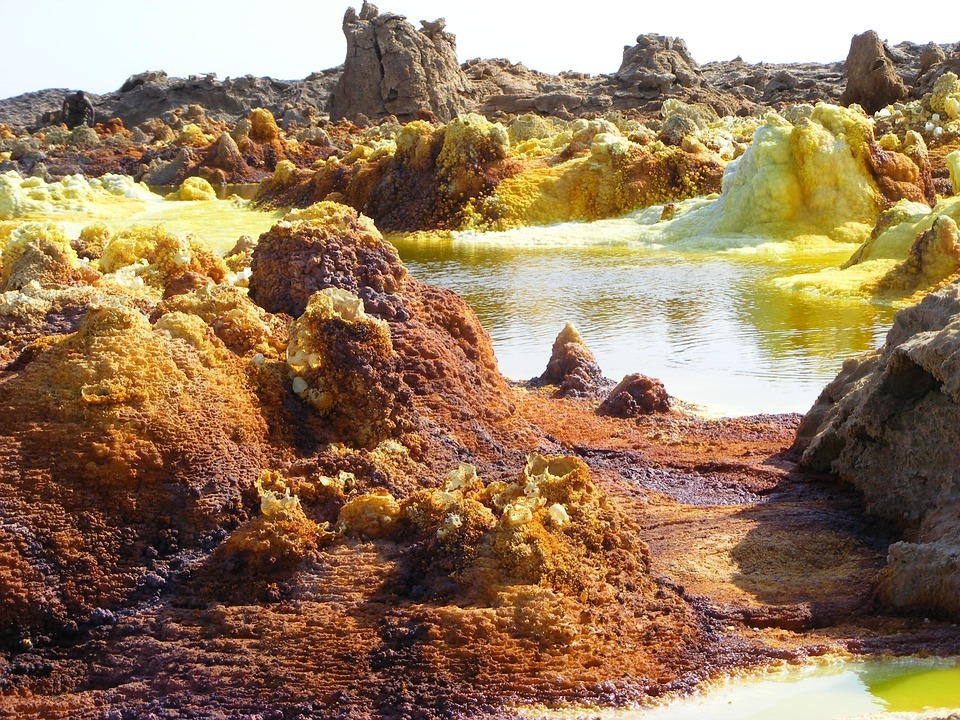How does it feel like to be in one of the earth’s most inhospitable places? You think of vast deserts such as the Sahara Desert, any deserts in the Middle East, or the Death Valley. You have probably been to any of these places and endured the oppressive heat and harsh conditions.
Then, you might be able to make it to Danakil Depression – one of the hottest, driest, and lowest places on the planet. Lying more than 100 meters below sea level, this desolate desert region is situated on the northern part of the Afar Triangle (or Afar Depression) in the Afar Region, one of the nine regional states in Ethiopia. The Afar Region is also part of the East African Rift System, which is an active tectonic plate boundary that is moving plates apart at a rate of seven millimeters per year.
A cruel environment
As for the climate, it can be best described as cruel. But you might be surprised that there are people who live there. Its average year-round temperature is reportedly 34.4 degrees Celsius (93.92 degrees Fahrenheit), but it can get as high as 55 degrees Celsius (131 degrees Fahrenheit) during the summer months. Aside from the climate, the geothermal heat caused by volcanic activity also contributes to Danakil’s scorching temperatures.
Danakil Depression experiences very little to no rain throughout the year. The Awash River, Danakil’s only major waterflow, cascades from the Ethiopian highlands and flows down into the region’s lakes. Not surprisingly, the river never reaches the sea as Danakil’s intense heat causes the river to dry up, leaving a chain of salt lakes.
Aside from the salt lakes, Danakil also has numerous lava lakes that bubble inside the volcanic calderas of the Dallol area. It is also dotted with several hot springs and hydrothermal pools, which reek of rotten egg-like odor that permeates the air.
Erta Ale, Ethiopia’s most active volcano, is located in this region. It is known for holding the longest-existing lava lake, continuously spewing large volumes of lava. Erta Ale is one of the only eight volcanoes in the world that have lava lakes.
Walking around the strange area feels like you’re on another planet, or you’ve stepped onto a lunar landscape. There are volcanoes whose bubbling lakes light up the night sky. The volcanic activity results in numerous faults and fissures that mar the landscape, as well as steaming geysers and hot springs. The sight of the multi-colored hydrothermal fields and vast salt pans are breathtaking, you cannot help but be dazzled even in the face of Danakil’s oppressive environmental conditions.
The blazing heat and perennial dryness make you think that life would be almost impossible in Danakil. But you will be surprised to learn that there are people who live there, against all odds. The Afar people have made this inhospitable place home. They make their living by cutting salt blocks from the lakebed, then selling them to the nearest market on the backs of camels and donkeys.
A treasure trove for scientists
Danakil seems to be a world away from civilization and offers very little when it comes to hospitality. However, it is a treasure trove to scientists. Geologists come to Danakil to study its unique and complex geological history and features.
Despite its inhospitable environment, Danakil is home to several microorganisms. The region’s blazing temperatures and highly saline environment make an ideal place for these microorganisms to exist. These microorganisms, called extremophilic microbes, can survive and even thrive in extreme environmental conditions when other life forms normally cannot. These extremophilic microbes continue to be a major interest to astrobiologists, as they can hold clues to the possible existence of extraterrestrial life.
Even paleontologists and anthropologists have unearthed a famous and important discovery in this region. In 1974, American paleoanthropologist and his colleagues discovered an Australopithecus afarensis fossil. This fossil, whom they named “Lucy,” is believed to have lived between 3.9 and 2.9 million years ago. Many other fossils of ancient hominins have been discovered in this region. These discoveries have prompted some paleontologists and anthropologists to suggest that this is the area where our species evolved. As a result, the region is often referred to as the “cradle of humanity.”
The Danakil Depression may be the harshest, most hostile, and most cruel place on the planet. But it also boasts some of the world’s most fascinating natural landscapes. It is also the place where the dawn of humanity began. Not to mention that it may hold clues to the possible existence of alien life. This region is full of wonders that continue to leave us amazed, baffled, curious, and dazzled.
